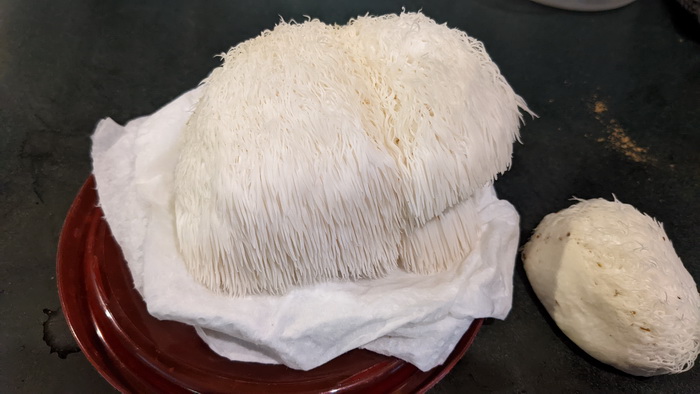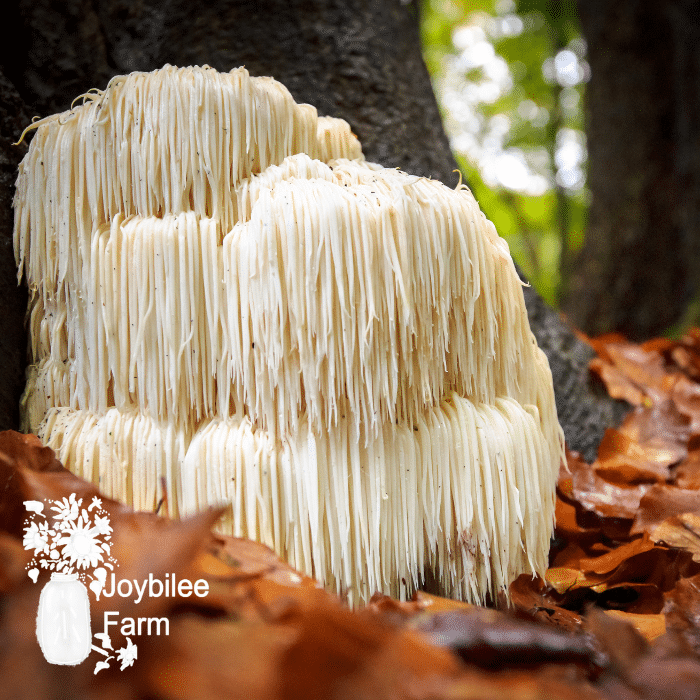Learn how to grow lions mane mushrooms, and enjoy these tasty, toothed, gourmet and medicinal mushrooms at home. Lions mane mushrooms are a fun wild mushroom to forage for, and a safe and fun mushroom to grow at home, on logs or in sawdust. These mushrooms have a distinctive flavor, slightly sea-food like, and look like fuzzy pom-poms.
If you happen to be fortunate enough to live in an area where lions mane mushrooms grow wild, these gorgeous mushrooms are great to wild-harvest and have no identical look-a-likes. Otherwise, you can cultivate your own lions mane mushrooms, at home with a few simple tools and resources.
These mushrooms are unique in that they are one of the few varieties that will grow, and thrive, on black walnut wood. Most mushroom varieties cannot grow directly on walnut, or butternut, due to the jugalone content, though wine cap mushrooms can grow in the root zone of walnuts and help reduce the jugalone load in the soil, so more plant species can thrive.
Getting Started:
Lions mane mushrooms are slow growing, but form large mushrooms, so a solid log is the best choice for them. If you are finding your own logs, look for maple, oak, or birch, you can also use black walnut. Maple is the mushroom’s favorite wood type, but the other wood types will give satisfactory growth and production as well.
Cut fresh logs in the early spring, when possible, and let the cut logs age 3-4 weeks. While ageing the logs, keep them off the ground to prevent other fungi species from beginning to colonize. Keep the logs out of the direct sun, as you just want to let the wood’s natural anti-fungal properties wear down, and don’t want them to dry out too much.
Trim off any branches from your cut logs, and lightly scrape off lichens. Leave the bark as intact as possible, as that will help the mushrooms along by preserving moisture. Logs should be no more than five feet in length, and from 1.5-3 inches in diameter, for ease of handling, stacking, and storing.
How to grow lions mane mushrooms:
- You will need sawdust or plug spawn. This method is for sawdust spawn. One bag of sawdust spawn will inoculate 14+ logs, while a bag of plug spawn will inoculate about 7 logs. Sawdust can be a challenge to work with and takes a bit more time and effort. If you have wrist or joint issues in your hands, work with plug spawn.
- 14 hardwood logs, birch, maple, oak, or walnut, aged 3-6 weeks from being cut down.
- 1/4 pound beeswax for sealing the inoculation holes
- A tin can and pot double boiler system to melt the wax
- Sawdust inoculation tool, also known as a palm tool.
- 12mm drill bit, Mushroom specific bits have a stop installed at 1/2 inch depth, you can do a similar thing with tape on a regular drill bit.
- An electric drill
- A large bowl
- Daubers for applying the wax to the log
- Helpers, this task is quite involved and will take 2 afternoons for one person to drill and inoculate all the logs. With two or three people, you can complete the task in about 4-6 hours.
- Gloves, wear gloves when handling spawn.

Secure the first log so that it won’t roll around. Starting 2 inches from one end, drill holes at 4 inch intervals up the length of the log. Rotate the log a 1/8th turn. Chose a point mid-way between the last two holes on the previous row, and drill the first hole of this row. Repeat, staggering spacing, for the new row. Turn log, and repeat for the next row of holes, until the log is covered in holes on approximately 4 inch centers.
Working on a separate table, if you are doing this as a work-B. Break up the sawdust spawn into a large bowl. Crumble it well, it fills the inoculation tool better if it’s well crumbled first. If your spawn feels very dry, mist lightly with water and mix the spawn about a bit.
Jab the inoculation tool into the spawn a few times, so that the open end fills up. Align the end of the tool with one of the drilled holes on the log, and depress the plunger with force. Remove the tool and tap the spawn in the log hole to make sure the hole is adequately filled. Each newly filled spawn hole should be level with the wood, or slightly indented. It should not be raised over the level of the log’s bark, as then it may not fully seal when you apply the wax.
Repeat the process with the inoculation tool until every hole in the log is filled. Set the log aside.
When you have 3-5 logs done, or all your logs, melt down the beeswax in your double boiler. An outdoor propane burner works well to keep the wax at a workable temperature while being close to your workstation and watched.
When the wax is melted, use a dauber to apply the melted wax to each of the spawn-filled holes in the log. This seals in moisture, seals out competing fungi, and lets your desired lions mane mushrooms grow.
When all the logs are inoculated and sealed, set them aside in a shady area. Make sure to place your logs on spacers, so no ground fungi jumps to your new mushroom logs. If you store your logs upright, make sure to flip them once a month so that the mycelium will grow evenly.

Fruiting your Mushroom Logs:
Lions mane mushrooms are a slower mycelating variety, and will take 6-18 months to establish well enough to begin fruiting. Keep your mushroom logs in a cool, shady area throughout the summer seasons, and water two or three times per week to help encourage the mycelium to run throughout the wood.
The next spring, stand your logs upright and mist. As temperatures reach 65-70 degrees F (18-21 degrees C) you may start to see some fruits forming. Lion’s mane forms slowly, starting as a white puffball pin, and gradually growing into a larger puffball and eventually developing its characteristic “spines” which can be up to two inches long. When the tips of the oldest spines start to show signs of discoloration (pink, yellow, brown), harvest immediately as the mushroom is full-size.
To harvest your lion’s mane mushroom, cut off the mushroom close to the trunk with a sharp knife. If you leave a bit of flesh on the log, it can regrow a new mushroom on the old spot in the same growing season. If you completely remove the mushroom, the log will wait till the next round of ideal humidity and temperatures to fruit again.
Logs should naturally fruit in spring and fall, whenever humidity and temperatures reach the mushroom’s ideal.

Learn more about growing mushrooms in the garden
Sarah’s new book, Growing Mushrooms for Beginners, A Simple Guide to Cultivating Mushrooms at Home, is available on Amazon and Barnes and Noble. In this concise resource Sarah guides you step by step through growing mushrooms on logs, on straw, on wood chips in the garden, or even in Mason jars in your kitchen. The book includes instructions for growing seven mushrooms including shiitake, oyster, lions mane, garden giant/wine cap, and more. Learn the unique characteristics, flavors, health benefits, and specific growing requirements for each mushroom as well as space saving tips and recipes to get the most out of your mushroom harvest.








































![Air gun 101: The differences between .177 & .22 – Which jobs they do best ? [Infographic]](https://airgunmaniac.com/wp-content/uploads/2020/09/g44-150x150.jpg)



